
Odia is an Indo-Aryan classical language spoken in the Indian state of Odisha. It is the official language in Odisha, where native speakers make up 82% of the population, and it is also spoken in parts of West Bengal, Jharkhand, Andhra Pradesh and Chhattisgarh. Odia is one of the many official languages of India; it is the official language of Odisha and the second official language of Jharkhand.

The Odia (ଓଡ଼ିଆ), formerly spelled Oriya, are an Indo-Aryan ethno-linguistic group native to the Indian state of Odisha who speak the Odia language. They constitute a majority in the eastern coastal state, with significant minority populations existing in the neighboring states of Andhra Pradesh, Chhattisgarh, Jharkhand and West Bengal.
Odia literature is literature written in the Odia language, mostly from the Indian state of Odisha. The modern Odia language is mostly formed from Tadbhava words with significant Sanskrit (Tatsama) influences, along with loanwords from Desaja, English, Hindustani (Hindi/Urdu), Persian, and Arabic. Its earliest written texts date from around 1000 CE. The earliest Odia newspaper was Utkala Deepika, first published on August 4, 1866.
Odisha is one of the 28 states of India, located on the eastern coast. It is surrounded by the states of West Bengal to the northeast, Jharkhand to the north, Chhattisgarh to the west and northwest, and Andhra Pradesh to the south and southwest. Odia is the official and most widely spoken language, spoken by 33.2 million according to the 2001 Census. The modern state of Odisha was established on 1 April 1936, as a province in British India, and consisted predominantly of Odia-speaking regions. April 1 is celebrated as Odisha Day.

Sitakant Mahapatra is an Indian poet and literary critic in Odia as well as English. He served in the Indian Administrative Service (IAS) from 1961 until he retired in 1995, and has held ex officio posts such as the Chairman of National Book Trust, New Delhi since then.

The Odia cinema, colloquially known as Ollywood, is the Odia language Indian film industry, based in Bhubaneshwar and Cuttack in Odisha, India. The name Ollywood is a portmanteau of the words Odia and Hollywood.

Bishwanath Das né Biswanath Dash was a politician, lawyer and philanthropist from India. He was the prime minister of Odisha Province of British India 1937–39, the governor of Uttar Pradesh 1962–67 and later the chief minister of Odisha 1971–72.
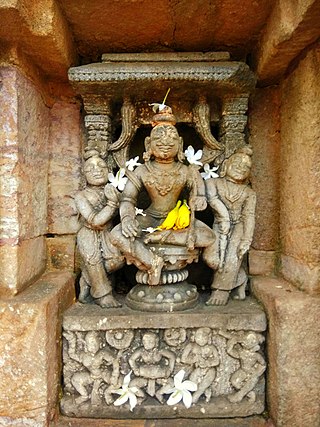
Kapilendra Deva was the founder of the Suryavamsa Gajapati Empire that ruled parts of eastern and southern India with the present-day Odisha as the center of the empire. He ascended to the throne after staging a military coup against the preceding and the last ruler from the Eastern Ganga dynasty, Bhanu Deva IV. He is also referred to as Kapilendra Routray or Sri Sri Kapilendra Deva. Kapilendra claimed descent from the Surya Vamsha of the Mahābhārata and was conferred the regnal title Shri Shri ...(108 times) Gajapati Gaudeshwara NabaKoti Karnata Kalabargeswara i.e. the Lord of Bengal (Gauda), the lord of the Karnataka region or Vijayanagara, the Lord of Kalaburagi and of nine crore subjects.

The Odisha Pradesh Congress Committee(1921-2024) was the unit of the Indian National Congress for the state of Odisha. It is responsible for organizing and coordinating the party's activities and campaigns within the state, as well as selecting candidates for local, state, and national elections in Odisha.
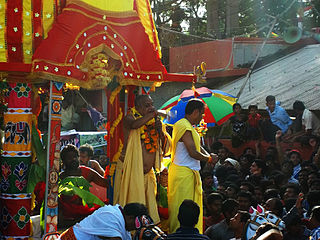
Dahuka boli are poetic recitations which Dahukas, the charioteer who recite during the Rath Yatra in Puri, Odisha. Ratha Yatra being a symbolic expression of fertility and Life cycle, these "boli" sung by the Dahuka contain bawdy songs. It is believed that unless the Dahuka boli is sung 'Ratha' doesn't move. These songs are sung publicly without any kind of hold on the lyrics. Dahuka controls the movement of Ratha during the festival. This tradition is the remnant of Vajrayana Buddhism in Odisha and the lyrics bear the signature of the Vajrayana Buddhist poetry. The Dahukas are believed to be the descends of the famous 84 Mahasiddhas.
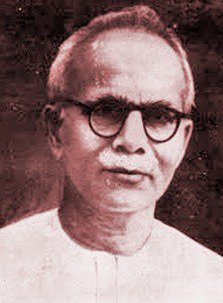
Pandit Godabarish Mishra was a poet and notable socialist from Odisha, India. He is known for his contribution to Odia literature.

Prafulla Kar was an Odia musician, singer, lyricist, writer and columnist. He was also famous for his Odissi Music recital. He received Padma Shri, the fourth highest civilian award by the Government of India in 2015 for his contribution in the field of arts.
Binod Chandra Nayak was an Odia writer. He was known for his writing that was influenced by modern poetry while being romantic. He was awarded the 1970 Kendra Sahitya Akademi award for his poetry collection Sarisrupa.

Mardala is a classical percussive instrument native to the east Indian state of Odisha, traditionally used as the primary accompaniment in Odissi classical music. The instrument is slightly different from other instruments that might have similar names in the Indian subcontinent due to its unique construction, acoustic features and traditional playing technique.

Karani script was a cursive/calligraphic style variant of Odia script developed by the Karana (କରଣ) community/ the scribes of the Odia royal courts. It was used in the pre-Independence Orissa (Odisha) region of British India and was primarily used by the Karana community who were working for administrative purposes, documentation and keeping records in the royal courts of the Odia princely states. The name Karani is derived from the metal stylus, Karani that was used for writing on palm leaf.
Desia, also Desiya or Desia Odia or Koraputi Odia or Southwestern Odia, is an Indo-Aryan language variety spoken in Koraput, Nabarangpur, Rayagada, Malkangiri districts Odisha and in the hilly regions of Vishakhapatnam and Vizianagaram districts of Andhra Pradesh. The variant spoken in Koraput is called Koraputia.

PanditRamhari Das is a leading singer, composer, musicologist and Guru of Odissi music. Known for his renditions, compositions, lecture-demonstrations and writings, Das has served as a professor and led the Odissi vocal department in prominent musical institutions of Odisha, including the Utkal Sangeet Mahavidyalaya and the Utkal University of Culture. He is the founder of Ramhari Das Odissi Gurukula at Biragobindapur, Puri. For his contributions to Odissi music, Das received the Sangeet Natak Akademi award in 2008.
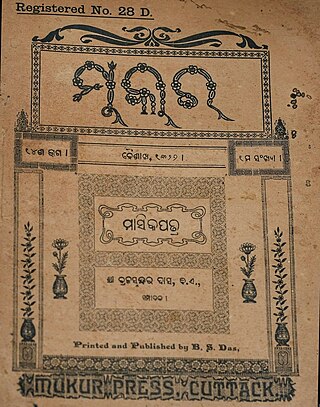
Mukura was a 20th century Odia magazine. It was founded by Brajasundar Das in 1906 in Cuttack, Odisha and was published for about 25 years, with its last issue in 1930. Brajasundar Das was the editor of this magazine. It cost Rs. 2 at the time.
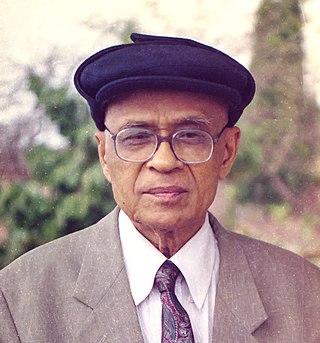
Lakshman Kumar Mahapatra was an Indian anthropologist born in Odisha. He graduated in anthropology from the University of Calcutta and received a doctorate from the University of Hamburg. He was Vice-Chancellor of Utkal University in 1986 and Sambalpur University in 1989. While heading the anthropology department at Utkal University, he was the first academic in India to start a course on Southeast Asia in the regular curriculum at the university level in India.

















